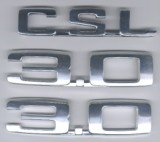

| site search byfreefind | |||
|
|||
Amazing to think that one of today’s most desirable and respected car manufacturers was on the brink of bankruptcy in the late 1950s which nearly led to the consumption of BMW by Mercedes-Benz. Indeed had it not have been for the financial intervention of financiers Herbert and Harald Quandt that BMW may not have been able to achieve the engineering prowess and fine reputation that it has become synonymous with. Following this cash injection, BMW pitched themselves strongly at the middle-class sector of the market and unveiled the 1500 and the elegant 3200CS coupe models at the 1961 Frankfurt Motor Show, both of which were received very well and paved the way for the ultra-successful future of the company. In 1968 the 2500 saloon was launched and it was this car that gave birth to a string of elegant coupes that peaked with the CSL ‘Batmobile’. The first such model was the 2800CS and with independent suspension, taught chassis and a 170bhp powerplant this made it an attractive candidate for circuit racing. While the factory did not take the CS to the track at first, renowned performance tuning company Alpina (amongst others including Schnitzer) did though and the first major victory came in 1970 when a BMW CS won the prestigious Spa 24 hour race in Belgium. Ford meanwhile was still dominating on the track with the Capri but in 1971 BMW decided to get seriously involved and introduced the CSL (coupe sports lightweight) derivative. In drastic efforts to homologate a more competitive racing car the monocoque was formed from thinner gauge steel and aluminum was employed to skin
the, bonnet and boot. An array of luxuries were also deleted such as front bumper (the rear bumper was now formed of polyester) along with the extraction of power steering, electric windows, thick carpets, comfortable seats and sound deadening; in total 250kgs was shaved off the curb weight. Despite this, Ford managed to keep the Capri ahead of the CSL on the track thanks largely to the supreme efforts of their engineers Jochen Neerspach and Martin Braungart. In 1972 though BMW took the tact that `to beat them you have to buy them’ thus Neerspach and Braungart joined BMW and were catalysts for the formation of BMW Motorsport Gmbh. By the end of the year, thanks to exploiting various loopholes in the regulations, the BMW became a winner (at least in one round of the German Saloon Car Championship).
BMW had not yet won a European Championship round though thus one of the most outrageously brutal, road going homologation specials was conceived in order to do so. To improve downforce the front gained a deep air dam, the fenders grew pronounced air guides and a trunk lid lip spoiler was added. Though not able to be supplied fitted by the dealers in Germany, the dynamic beast also came with a roof mounted deflector and a huge two part rear wing (so large and heavy that BMW had to revert back to a steel trunk panel in order to support the weight of it under load!). Whilst still being badged as a 3.0 CSL, the engine’s stroke was increased which in turn saw the engine capacity rise to 3,153cc. The menacingly staunch profile of the new CSL soon earned the nickname `Batmobile’ (in direct comparison to the Caped Crusader’s own mode of transport) with a mere 110 first series and 57 second series cars leaving the factory until production ceased in December of 1975. As an immediate result with the homologated improvements, BMW beat Ford in style during the 1973 European Touring Car Championship whilst making for some of the best racing battles of the era. At the end of the 1974 season, BMW and Ford withdrew from the series (largely due to the effects being felt from the oil crisis in the Gulf) but in private hands the `Batmobile’ remained a winner. The factory did though return a couple of years later with the CSLs in Group 5 racing but the already generous allowances did not require for road-going derivatives to be built. It should also be noted though that one of the final works of the much-celebrated artist and sculptor, Alexander Calder (1898-1976), was for him to livery one of the factory race cars to his design, it is of course one of the famous BMW `Art Cars’ and is retained to this day by the BMW factory.
These cars were designated "E9" coupes in BMW's internal naming system.


